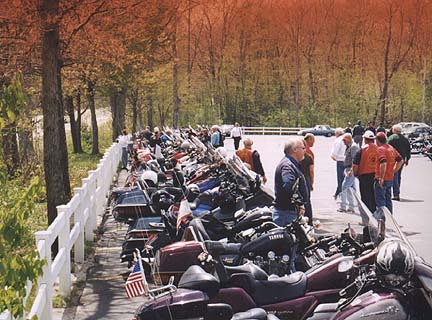Thoughts to discuss at a DRIVERS' MEETING before the ride:
- What is the route to be taken? Does everyone know where the ride is going? Do people need maps?
- What if the group gets broken apart? It is unsafe to keep the group together and in the process violate traffic laws (go through red lights, stop signs, excessive speed, etc.) and endanger our group and to hurt the public's image of motorcycles and motorcyclists.
If the group is broken apart are we going to use "Assistant Road Captains" to lead the smaller groups? Are we going to re-group at certain known points along the route? Are we all equipped with two-way radios and will keep "together" via radios?
Another way to allow the group to continue without loosing those who become separated is that the group takes a corner and their are riders that are further behind the group, the final bike that remains with the group waits at the corner until visual contact is made with the bike or bikes that have fallen behind. If at each corner a bike from the group waits, then those catching up will always know the direction of travel taken by the lead bikes.
- What are the fueling points and rest stops along the route? What are the duration of travel that the bikes in the group can take? Are they all touring bikes with 200+ miles of gas available or are there bikes with smaller gas tanks along for the ride?
And even if the bikes have a 200+ mileage range with the gasoline aboard the bottoms of the riders probably would appreciate stops along the way.
- Be sure that all those preparing to ride with you have proper gear, water, or whatever else might be needed for the ride.
Make sure that everyone has fueled up and emptied out before you leave... gas in the bikes and water out of the riders!
- What to do in case of emergency?
Do you know everyone that is riding with you? Even if you do, having a list of emergency information of those with you is a good idea. Who to call if there is an emergency? Do they have towing insurance? Do they have any medical problems that you should know about?
Who in the group has cell phones or two-way radios?
Have a riding team emergency plan. In the event of an emergency who in the group will be in charge of making the 911 call? Who will go for help? Who will be in charge of first aid or care of the rider in need? Who will warn oncoming traffic?
- Who is the leader of today's ride (Road Captain)? Who is the rider at the end (Tail Gunner)? Are there assistant Road Captains within the group?
- What is the recommended procedure when passing slower traffic? Is it bike by bike or as a group?
- Will the group be using hand signals? What are they? Does everyone have a two-way radio? What channel are you operating on? If not consider placing the bikes without radios between the bikes with communication. Remember to communicate with those without radios too.
Even though you are riding as a group, remember to Ride Your Own Ride! Be comfortable with the speed you are riding. Don't exceed your comfort level or endanger yourself or other riders.
Have a Great Ride!
|
